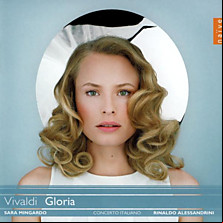BBC Review 1bj6o
This is Vivaldi as it should be.
Katie Greening 2009
We’re in the midst of a Vivaldian revolution at the moment. The Vivaldi Edition, a recording venture set up in 2000, is in full swing – the plan is to record the complete collection of Vivaldi manuscripts housed by the university Library in Turin by 2015. They’re about halfway through the 450 works, many of which haven’t been performed since the 18th century.
This album is part of the project, and features two Vivaldi Glorias, plus an introductory motet. RV589 is so well known that it tends to be called ‘the’ Vivaldi Gloria; RV588, on the other hand, is rarely performed. They were composed around the same time in the early 1700s, which was a fascinating time for sacred music. With the opera genre flourishing, audiences were beginning to expect church music to live up to the expressive, theatrical music they heard at the opera house – no more plainchant or unaccompanied polyphony. These Glorias neatly reflect the change in style.
The introductory motet, Ostro Picta, has only been recorded four times before. With two superb arias by Monica Piccinini, it’s a cheery, zesty appetiser-of-sorts to Gloria RV589, which immediately follows. This version is very speedy – Alessandrini’s trademark style – but, I think, wonderful for it. The highlight of the whole disc is the famous opening Gloria in Excelsis Deo, performed at high-octane speed. Too often this work can descend into dull turgidity – here it crackles with excitement and tension throughout.
Gloria RV588 is a very different work. It’s less theatrical, and for that reason it’s likely to have been written earlier than RV589; it’s also, sadly, rather less interesting. However, the performance is an even and expressive one – it runs at a cracking pace, too – and worth listening to alone for solos by Sara Mingardo, whose rich yet light voice is perfect for this music.
Vivaldi is, to coin a phrase, like soufflé – easily too light, or too stodgy, and either way falling completely flat. This album happily avoids such pitfalls, with a performance that celebrates the rich drama and excitement of Vivaldi while maintaining a lightness of touch throughout. In short, this is Vivaldi as it should be.



